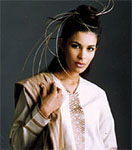


|
|

|
| HOME | LIFE/STYLE | COLUMNISTS | A LA MODE | ||
| September 24, 1997 |


For many years now, the east has consistently being losing the fashion battle to the west. But the turn of the century just might see the Oriental giant racing ahead. Spring-Summer '98 seems to show a distinct slant towards the east, if the 10th Fashion Connections, Singapore, '97, is anything to go by. Asiatropic definitely seems to be the look of the coming season. The multi-nation extravaganza saw top designers from Singapore, Malaysia, Thailand, Indonesia, Philippines, Vietnam and India nudge international fashion in a new direction. India's Gitanjali Kashyap, the capital's leading designer for over a decade, stole the show with her opening collection titled 'On the Banks of the River Ganges'. Biyan of Indonesia transformed woman into an angel in swirl of flesh-coloured net, lace and chiffon. But what exactly is the Asiatropic style? Is it creations with eastern touches for the orient or with a western twist for Europe? Whatever the definition, it has a distinct look that is bound to appeal to both the oriental and the western woman. Besides, fashion always welcomes anything new. The coming years just might see a Asiatropic blitz sweep the fashion world. After all, European designers have been raiding the east for creative 'inspiration' for far too long. It's time the vanquished made their own sartorial statement.
Delhi-based designers Soma Kumar, Ranna, Seema Roy, Anju Modi and Vijay and Shobhana Arora recently displayed their version of fashion. Mahatma Gandhi, Sarojini Naidu, Jawaharlal Nehru and Khan Abdul Gafar Khan were Kumar's inspirations. Ranna worked on a look revolving around Subhash Chandra Bose. Roy weaved in sacrifice, while Modi projected non-violence through khadi. The Aroras turned nostalgia into a new fashion angle. It's amazing how fashion always blends into the events of the year. Mahatma Gandhi used it to make a freedom statement when he asked Indians to wear khadi. It's definitely a more glamorous way of making one's point. Reviving textiles in all their beauty, both in India and in the west, has been part of Ritu Kumar's fashion mission ever since she launched herself as a designer. Her latest labour of love, 'Sutra -- the thread that binds', was exhibited at the prestigious Glasgow School of Art, London. It focused on three aspects of India's rich textile heritage -- kalamkari, zardozi and desert embroidery. Kumar's name has been synonymous with the revival of Indian textiles and crafts. Little wonder, therefore, that when the late Princess Diana wanted an authentic Indian ethnic outfit, she went directly to Kumar's boutique in London. For a Ritu Kumar ensemble is a painstakingly researched garment that will stand the vagaries of the fashion world and remain a show stopper. Very few Indian designers will go all out to encourage competition. After all, it is a dog-eat-dog world. Yet Ritu Beri stole time from her busy schedule to organise the Ritu Beri Fashion Fraternity show in Delhi. It showcased the talent of 22 young designers through a fashion fair and three shows held at the grand ballroom of the Taj Palace Hotel. That India does not lack talent was evident in this show. Jatin Verma's velvet creations won him two awards and Gaurav Chabra walked off with the Siyaram Trophy and the cash prize. Buyers from stores around the country flocked to take a look. It's their innovativeness that is making buyers takes a look at these young designers. Not a bad idea after all. For there may come a time when the 50-odd designers who hold sway on the designing world get boring, since fashion is a business of innovation and evolution.
Bengal, Sikki, Tangail, Rajput, Godari, Nirvaan, Mud Painting, Cyber India and Warli styles were converted into into sellout garments. While the salwar-kameez slipped back to basic A-line. Simplicity, it seems, rules the look. Another store in the country that has made simplicity its hall mark is Bandhej in Ahmedabad, where prices are affordable and the style, elegant. Traditional fabrics, coupled with the 90s look, give ethnic wear a new silhouette. Stores that can offer such combinations will definitely strike the right fashion cord in the Indian woman's heart.
|
|
|
Tell us what you think of this column
|
Meher Castelino
|
|
|
HOME |
NEWS |
BUSINESS |
CRICKET |
MOVIES |
CHAT
INFOTECH | TRAVEL | LIFE/STYLE | FREEDOM | FEEDBACK |
||